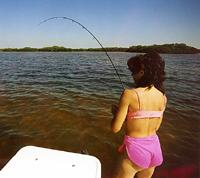
A Spinning Rod for the Flats:
A Case for Custom Built Rods
by Capt. Fred Everson
When I started designing flats rods five years ago, I knew what I wanted the rod to do, but I wasn’t quite sure how to achieve it. |
| Extra rod length gives the advantage of more leverage. You can put a lot of pressure on a fish with a long rod. |
I started out with a fairly light blank at a length of 8 ½ feet. I thought that first rod a bit unwieldy because I was fishing a heavy chrome spoon. It was and is a good lure to cast, and it will catch fish, but mostly I think I liked it because I could cast it so far. A great lure for mackerel, but of limited use on a grass flat. I wanted a rod tailored to throw a more practical, versatile lure, and I soon learned that lighter is better in shallow water.
I trimmed
 |
| Long rods also absorb the sudden power surges of big fish that often occur when they first see the angler or the boat. |
I used a Daiwa spinning reel on that first rod – a Regal Z 2500 – a fairly small reel that spools 170 yards of eight-pound test. I never hooked any outsized fish on that rod, but from fighting big reds, and some jacks in the ten pound class, I was satisfied that trophy snook wanted stronger medicine. I was also experimenting with different brands of monofilament between six and 14-pound test, seeking a perfect match of rod, reel, line, leader, and bait.
I went up a couple of sizes in the blank and kept the length at 8 feet. I stayed with the same reel
 |
| The shorter handle design is convenient for sidearm casts and less tiring when fishing artificial baits. |
When I hooked a 36-inch snook on the flats with this rig, it took me near the bottom of the spool twice. A bigger snook would have spooled me, and I had seen a couple around.
I went back to my tackle supply catalogue and found a 9 foot blank that was slightly heavier, American made, and 100 percent graphite. I ordered three of them, along with a slightly longer cork handle, a bigger reel seat, and a 3500 Daiwa Regal Z which would spool over 200 yards of 10 pound test. I cut the blank back 9 inches for an overall length of 8’3”.
This rig was heavier because of the larger reel, but not much. It is still lighter than most 7 foot
 |
| In clear, shallow water, long casts on light line with light baits is essential – extra rod length helps. |
The length of the rod casts the soft plastic Riptide Jerk Bait much farther than you would expect. And it throws the more aerodynamic Salt Rat, also by Riptide, even better. With my latest flats rod, I am confident that I could land any snook I encounter on open water, and just about everything else outside of giant tarpon and big cobia.
This doesn’t mean the process of experimentation is over. There are other guides to try, and other blanks. All I have down is the size and shape, and the basic design. For me the fun in rod building and design is to try something and have it work. I will keep experimenting with guide ring sizes, and materials. For example, I would like to try the Fuji Cermet guides, but a nine-guide set can cost almost $200. I would also like to experiment more thoroughly with guide sizes.
But for right now, I have a well-designed rod to fish the flats. A rod that has been carefully matched with the reel, line strength and capacity, lure, and the size range of fish, and the different species I am apt to hook. Try getting all that out of an over the counter rod. I queried a major manufacturer about marketing my design, and he replied that fishermen on the Pacific Coast preferred longer handles. Precisely. Why fish with a rod designed by some guy in California who has never seen a snook?
Nor are my early designs collecting dust. Those first rods are ideally suited to trout, small reds, ladyfish, and those summer school sized jacks of a couple pounds. With six-pound test,
 |
| Unweighted jerk baits are low impact lures that won’t spook fish in shallow water – and you can rig them weedless. |
There is no such thing as a good all around rod in South Florida because of the great variety in fish size and species, and habitat, even if you don’t go offshore. The rod you use for fishing bridge pilings at night needs to be very different than one you would fish on open water flats with small baits. And there is no better way around the dilemma, than a battery of custom-built rods, each perfectly suited to its intended task.
And now that I have my spinning
rod design where I want it, I will turn my attention to a bait-casting rod for
fishing residential canals and docks for wintertime snook – yet another case made
for specialized, custom built fishing rods.
Click on above photos for larger version,
remember to use your browser's back button
to return.
![]() You
can contact Capt. Fred Everson at:
You
can contact Capt. Fred Everson at:
1807 Kofresi Ct.
Ruskin FL 33570
(813) 641 3662
E-mail: [email protected]
Web Site: http://tampabayfishingguide.com/
![]() Back
to Fishing Articles
Back
to Fishing Articles